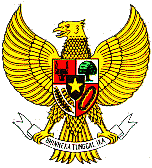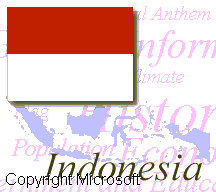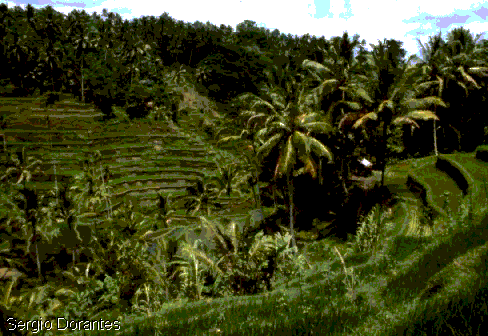
INDONESIA


Replubic of Indonesia, island republic of Southeast Asia, constituting most of the Malay Archipelago. The country consists of nearly 13,700 islands, almost half of which are inhabited, and stretches across some 5100 km (some 3200 mi) of sea in the region of the equator. Marine frontiers of Indonesia include the South China Sea, the Celebes Sea, and the Pacific Ocean on the north, and the Indian Ocean on the south and west. Indonesia has an area of 1,919,443 sq km (741,101 sq mi). The capital and largest city of Indonesia is Jakarta.
A stretch of relatively open water (consisting of the Java, Flores, and Banda seas) divides the major islands of Indonesia into two unequal strings of islands: the comparatively long, narrow islands of Sumatra, Java, Timor, and others on the south, and Borneo (Kalimantan), Celebes (Sulawesi), the Moluccas, and New Guinea on the north. A chain of volcanic mountains rising to heights of more than 3600 m (more than 12,000 ft) extends from west to east through the southern islands from Sumatra to Timor. The highest points on the chain are Kerinci (3800 m/12,467 ft) on Sumatra, and Semeru (3676 m/12,060 ft) on Java. Each of the major northern islands has a central mountain mass, with plains around the coasts. Puncak Jaya (5030 m/16,503 ft), in the Sudirman Mountains of Irian Jaya, is the highest elevation in the republic
The climate of Indonesia is tropical, with two monsoon seasons-a wet season from November to March and a dry season from June to October. The weather is more moderate between monsoons. The northern parts of the country have only slight differences in precipitation during the wet and dry seasons. Humidity is generally high, averaging about 80 percent yearly; the average daily temperature range (about 23° to 30° C/about 74° to 86° F at Jakarta) varies little from winter to summer. Rainfall in the lowlands averages about 1780 to 3175 mm (about 70 to 125 in) annually and in some mountain regions reaches about 6100 mm (about 240 in).

The rich volcanic soil of Indonesia is ideal for growing crops; forests flourish and cover about two-thirds of the land. Tin, bauxite, petroleum, natural gas, copper, nickel, and coal are major mineral resources, and small amounts of silver, gold, diamonds, and rubies are found. Saltwater fish are abundant, and the surrounding seas also yield pearls, shells, and agar, a substance extracted from seaweed. Bali is also well known by it's beautiful
Indonesian culture is an intermixture of many diverse civilizations. The Hinduism and Buddhism of India exerted a profound influence on Indonesian life and left a strong imprint on the architecture and sculpture of the country. Arabic influence in Indonesia has been promoted since the 13th century, mainly through the teachings of Islam. The islands have also been affected by Southeast Asian and Polynesian cultures, as well as by the influx of Chinese and Dutch peoples.
Early Kingdoms
By the 7th century two principal types of political units had emerged in the archipelago: the maritime trading states along the coasts of Sumatra, North Java, Borneo (Kalimantan), Celebes, and some of the other eastern islands; and the rice-based inland kingdoms, particularly of East and Central Java. The greatest maritime empire was Sri Vijaya (see Sri Vijaya, Kingdom of), a Mahayana Buddhist kingdom on Sumatra's southeast coast, which in the late 7th century was a center of trade with India and China and for some 500 years more or less monopolized much of China's trade with the western archipelago.
Little archaeological evidence of the Sri Vijayan Empire remains on Sumatra. In contrast, the Hindu-Buddhist kingdoms of Central and East Java left extensive temples, buildings, and inscriptions as evidence of the extent of Indian cultural influences on their religion and state organization. All these Javanese kingdoms were based on wet-rice agriculture and had a complex hierarchical administrative organization headed by a god-king. Inscriptions reveal that under the Sanjaya family the Hindu kingdom of Mataram flourished on the Diyeng Plateau in the early 8th century. In the second half of the century a Buddhist kingdom under the Sailendra dynasty developed in the nearby Kedu Plain. The Sailendras built the massive temple monument of Borobudur in the mid-9th century. By this time rulers claiming descent from King Sanjaya (reigned 732-778) of Central Java had founded a new kingdom of Mataram, ruling the east as well as the central part of the island. In the early 10th century, for unknown reasons, the kingdom's center shifted to the east, where Hindu influence on the state weakened. Under Sindok (reigned 929-947), and later united with Bali under Airlangga, the East Javanese Kingdom evidenced growing interest in overseas trade. After a period of division, the new kingdom of Singosari was founded on Java in 1222 by a commoner, Angrok (reigned 1222-1227) and under the Buddhist king Kertanagara (reigned 1268-1292) ascendancy was asserted over Sumatran areas formerly ruled by Sri Vijaya. Kertanagara's successor, Vijaya (reigned 1293-1309), repelled a Mongol invasion of Java and founded Majapahit (see Majapahit, Kingdom of), the greatest Javanese empire, in 1293. Majapahit, under Hayam Wuruk, claimed sovereignty over much of what is now Indonesia and parts of Malaya.
The Coming of Islam
By the late 13th century coastal north Sumatran states were beginning to accept Islam; the earliest known Muslim ruler there was Sultan Malik al Saleh of Pasai. Propagated by merchants, initially from south India and Gujarat, the new religion spread slowly until the rise of the sultanate of Malacca (Melaka) on Malaya's west coast gave it a powerful impetus. During the 15th century European demand for spices from the Moluccas, or Spice Islands, was growing, and by 1436 Malacca had become a major emporium on the trade route between the Moluccas and the West. In addition to its commercial and political power Malacca also became the major diffusion center for Islam. In the previous centuries Singasari and Majapahit had taken over the trade of Java's north coast principalities, which exchanged Javanese rice for Moluccan spices. Coastal Javanese, particularly those from Tuban and Gresik, now developed close ties with Malacca, converted to Islam, and became an important element in Malacca's population. Merchant princes from North Java came to run the trade between Malacca and the eastern archipelago, and their growing power exerted commercial and military pressure on Majapahit, contributing to its virtual disappearance by the early 16th century.
In 1511, however, Malacca was captured by the Portuguese. Their intrusion changed the existing pattern of trade in the archipelago and led to the emergence of several strong competing Muslim states that provided alternative trading routes. Muslim Aceh (see Achin) in northern Sumatra was Portuguese Malacca's leading opponent during the 16th century, launching attacks against it, either alone or with other local Muslim states. Under Sultan Iskandar Muda, Aceh controlled all Sumatra's pepper-trading ports except in the extreme south, and its influence extended to parts of the Malay Peninsula. Two other important trading states of the period were Makassar, in southwestern Sulawesi, which converted to Islam in 1603, and Bantam, the Muslim successor in West Java to the Hindu kingdom of Sunda, which controlled south Sumatra (and thus the Sunda Strait). In the late 16th century a new Muslim kingdom of Mataram arose in Central Java and began to absorb many of Java's maritime principalities.
The Development of Dutch Influence
The Dutch East India Company, founded in 1602, competed with the Portuguese and the English for the archipelago's trade. Governor-General Jan Pieterszoon Coen established Batavia (now Jakarta) as the Dutch headquarters and attempted to isolate the interisland network from the extensive international commerce in which it had participated. Dutch power expanded both by direct force and through alliances with native rulers. A brief clash with Mataram in 1629 was followed by a period of coexistence, and in 1678 Mataram ceded the Preanger region of West Java to the company. In 1641 the Dutch captured Malacca, but this no longer ensured control of the spice trade to Europe. To impose a monopoly the company restricted cultivation of cloves to Ambon and of nutmeg and mace to the Banda Islands, destroying the spice trees elsewhere.
During the 18th century the company introduced coffee and other new crops to Java and instituted a system of forced deliveries in which it relied heavily on cooperation from amenable Javanese aristocrats and intermediaries from the growing local Chinese population (whose immigration the Dutch promoted). Its interference in Mataram's affairs culminated in the kingdom's division in 1755 into the principalities of Surakarta and Yogyakarta. In the Spice Islands, Dutch trading rights were converted into effective political control; elsewhere in the eastern archipelago most local rulers retained their internal autonomy but were drawn into special relationships with the company. As the century wore on, financial mismanagement and a decline in trade eventually brought the company to bankruptcy and dissolution in 1799. The Dutch government then assumed control of its East Indian possessions.
The Consolidation of Dutch Control
During the Napoleonic Wars, under both the Dutch government and a British occupation (1811-1816), attempts were made to centralize and reform the administration of Java. On reassuming power in 1816, the Dutch wavered between opening the area to individual enterprise and reverting to a monopoly system. Their massive expenditures in suppressing resistance, led by the Javanese prince Diponegoro from about 1825 to 1830, ended this indecision. The Dutch annexed large areas of the Central Javanese principalities and in 1830 they introduced the so-called Culture System, whereby peasants had to devote a percentage of their land (officially one-fifth, but usually far more) to cultivating government-designated export crops instead of rice. Extremely profitable for the Dutch, the system was blamed for widespread famine in parts of Java in the 1840s and 1850s.
Deeper penetration of Javanese society by the Dutch was paralleled by extension of their control to other regions. On Sumatra they had imposed their rule over parts of the interior by 1837, and they annexed the northeast coastal principalities in 1858. Colonial rule outside Java was sometimes indirect.
A campaign by Dutch liberals against the Culture System succeeded by the 1870s in removing some of its harshest aspects. The new Liberal Policy then permitted more laissez-faire practices. Later oil, tin, and rubber began to replace coffee, sugar, and tobacco as the main exports to Europe. These products came largely from outside Java, and many new areas were now taken over. After a 30-year war Aceh was subdued in 1908, and Bali in 1909, by which time Sulawesi, the Moluccas, the Lesser Sunda Islands, and most of Borneo had all been brought under firmer control.
The Growth of Nationalism
At the beginning of the 20th century the Dutch introduced their Ethical Policy, under which agriculture and limited health and educational services were developed, and railways, roads, and interisland shipping expanded. The policy helped create two new social elements-a few Western-educated Indonesians and a smaller group of entrepreneurs, who began to compete with a still predominantly Chinese commercial class. These Indonesians grew resentful of a colonial structure that denied them a role commensurate with their education or abilities.
The first important vehicle for the anti-Dutch nationalist movement was the Sarekat Islam (Islamic Union), established in 1912. Growing out of a protective association for batik merchants, the Sarekat Islam by 1918 claimed a membership of more than 2 million throughout the archipelago. The Dutch response was initially conciliatory, and in 1916 the Volksraad (People's Council) was established where selected representatives of major population groups were able to deliberate and offer advice. However, after World War I (1914-1918), and especially after an abortive Communist-led insurrection in 1926 and 1927, the government adopted a more repressive policy.
Beginning in the 1920s the nationalist movement was headed by leaders who were not primarily Muslim, notably Sukarno, an advocate of complete independence, who founded the Indonesian Nationalist Party (Partai Nasional Indonesia, or PNI) in 1927. Despite the arrests and exiles of Sukarno (1929-1931, 1933-1942), Muhammad Hatta (1934-1942), and other nationalist leaders, and the banning of the PNI and other noncooperating parties, the nationalist movement maintained its momentum. Only after Germany overran the Netherlands during World War II (1939-1945), however, did the Dutch even hint at any postwar devolution (transference or surrender) of political authority.
The Japanese Occupation
During World War II the Japanese invaded and occupied the islands. Anxious to mobilize Indonesian support behind their regime, they gave Sukarno and his associates symbolic political latitude. Strategic concerns over access to resources, particularly petroleum, and the fear of Allied counterattacks bred repression. Moreover, tens of thousands of conscripted laborers worked as virtual slaves, and many of them did not survive.
Beginning in September 1943, the Japanese established militias in Java, Bali, and Sumatra, which gave thousands of young men military training and formed the nucleus of the postwar independence army. Indonesians, however, were alienated by the harsh behavior of the Japanese and by the growing economic hardships. To muster support against anticipated Allied attacks, the Japanese in October 1944 promised Indonesian independence, and subsequently took steps toward granting limited self-government.
The Postwar Struggle for Independence
On August 17, 1945, two days after Japan's surrender, Sukarno and Hatta proclaimed the independence of the Republic of Indonesia and were selected as its president and vice president. When British troops began landing on the islands in late September, a functioning republican administration was already in existence in many parts of Java and Sumatra. When the British withdrew in November 1946, they persuaded the Dutch and the republic to initial the Linggajati Agreement, which recognized the de facto authority of the republic in Java and Sumatra and contained plans for the establishment of a federal Indonesia.
In July 1947, however, charging violations of this agreement, the Dutch launched attacks against the republic, extending their control over about two-thirds of Java and large estates and oil fields in Sumatra. Protests in the United Nations (UN) led to the formation of a UN Good Offices Commission, which oversaw the signing of the Renville Agreement between the two sides. A Dutch blockade of republican territory caused intense economic hardship and increased popular dissatisfaction with the republic's policy of negotiating with the Dutch rather than consistently confronting them militarily. This was one element in the unsuccessful Communist-led uprising against the republic's leadership at Madiun in September 1948.
In December 1948, defying UN cease-fire lines, the Dutch again attacked the republic, capturing its capital of Yogyakarta and arresting and exiling most of its top leaders, including Sukarno and Hatta. Despite the apparent success of the initial Dutch attack, republican guerrilla resistance and pressure from the international community forced the Dutch toward accommodation. At a conference in 1949 in The Hague, the Netherlands agreed to transfer sovereignty over all Indonesia, except West Irian (western New Guinea), to the federal Republic of the United States of Indonesia (RUSI) by the end of that year.